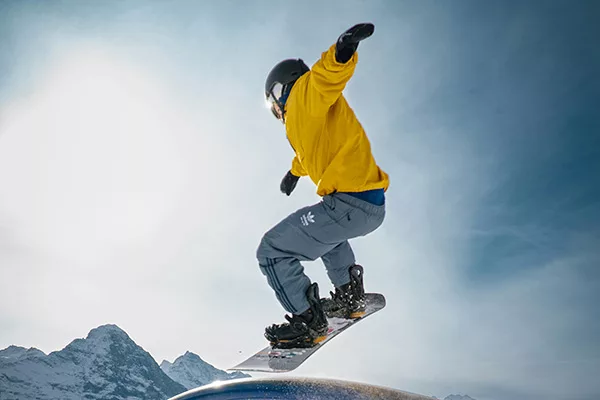Winter brings with it plenty of opportunities for outdoor fun, but it is important to be aware of the potential risks and hazards that also exist during cold weather. From skiing and snowboarding to ice skating and sledding, there are potential dangers and risks associated with most winter sports. While these recreational pastimes can be thrilling, it is also important to prioritize safety to prevent accidents and injuries.
Sledding and Tobogganing
Sledding and tobogganing are popular winter activities enjoyed by people of all ages. The thrill of sliding down a snow-covered hill can be exhilarating, but it is also important to sled in designated areas with a clear path and no obstructions. Choose a hill that is not too steep and has a gentle incline to prevent high-speed collisions. Always go down one at a time, never sled head first, and try to avoid icy or crowded hills. Wearing protective gear such as helmets and padding can also help reduce the risk of injuries.
Ice Skating
Ice skating is a graceful and enjoyable winter activity, but it comes with potential dangers if precautions are not taken. Choose skating rinks that have been properly maintained and cleared of any debris or cracks on the ice surface. Check the thickness and quality of the ice before stepping onto it, making sure it is safe to skate. Wear appropriate ice skates that fit well and provide ankle support. Avoid overcrowded rinks to prevent collisions, and always skate in the same direction as the other skaters to avoid accidents.
Skiing and Snowboarding
Skiing and snowboarding are exciting winter sports that require skill and caution. It is vital to wear appropriate protective gear, including helmets, goggles, and wrist guards. Before hitting the slopes, ensure that your equipment is in good condition and properly adjusted. Follow the rules and guidelines set by the ski resort or mountain, and stay within your ability level. Be aware of your surroundings and watch out for other skiers or snowboarders. Always use designated trails and avoid venturing into areas with potential hazards, such as trees or cliffs.
Winter Driving
Driving during winter can be challenging due to slippery road conditions and reduced visibility. Before heading out, check the weather forecast and road reports to stay informed about any warnings or advisories. Clear your vehicle of snow and ice completely, including the windows, mirrors, and lights, to ensure optimal visibility. Reduce your speed and increase the following distance between your vehicle and others to allow for safe braking. Avoid sudden maneuvers or harsh braking, as they can lead to skids or collisions. Consider equipping your vehicle with winter tires for better traction on icy or snowy roads.
Common Injuries from Winter Activities
Even if you take every precaution, there is always the risk that you can be injured, particularly if someone else is negligent. Common winter activity injuries include:
- Sprains and Strains. Some of the most common injuries during winter activities are sprains and strains. These injuries occur when ligaments or muscles are stretched or torn due to excessive force or sudden movements. Skiing, snowboarding, and ice skating are all activities that put strain on the joints and muscles, increasing the risk of sprains and strains. To prevent these injuries, it is important to warm up thoroughly before engaging in any physical activity. Stretching exercises can help to loosen the muscles and reduce the risk of injury.
- Fractures and Broken Bones. Falling is a common occurrence during winter activities. The impact of a fall or collision with a hard surface can cause bones to fracture. To minimize the risk of fractures, it is essential to wear proper protective gear, such as helmets and wrist guards while skiing, snowboarding, or ice skating. Additionally, learning the correct techniques and practicing good balance can also help to reduce the likelihood of falls.
- Concussions. Head injuries, including concussions, can happen during winter activities. Falls, collisions, or being hit by objects can result in a concussion, which is a type of traumatic brain injury. It is crucial to wear a helmet with proper padding and ensure that it fits correctly to protect the head from impact. If a concussion is suspected, seek immediate medical attention, and refrain from participating in any further activities until cleared by a healthcare professional.
- Frostbite. Frostbite is a condition that occurs when the skin and underlying tissues freeze due to exposure to extreme cold temperatures. Winter activities that involve spending prolonged periods outdoors, such as skiing or snowmobiling, increase the risk of frostbite. To prevent frostbite, it is important to dress appropriately for the weather, including wearing multiple layers, protective headgear, gloves, and warm boots. Limiting exposure to cold temperatures and taking regular breaks indoors to warm up can also help prevent frostbite.
- Hypothermia. Hypothermia is a potentially dangerous condition that arises when the body loses heat faster than it can produce it, resulting in a dangerously low body temperature. It can occur during prolonged exposure to cold temperatures, especially when proper protective clothing is not worn. Symptoms of hypothermia include shivering, confusion, and drowsiness. To prevent hypothermia, it is important to dress in layers, stay dry, and seek warmth if any symptoms of hypothermia are experienced.
While winter activities can be enjoyable, you must be aware of the potential risks and take precautions to avoid injuries. However, even when you take every precaution, someone else’s negligence can cause you to sustain injuries.
When this happens, contact Barber & Associates. We have been helping victims of winter activity injuries for many years to recover compensation to pay for medical bills and other expenses.
